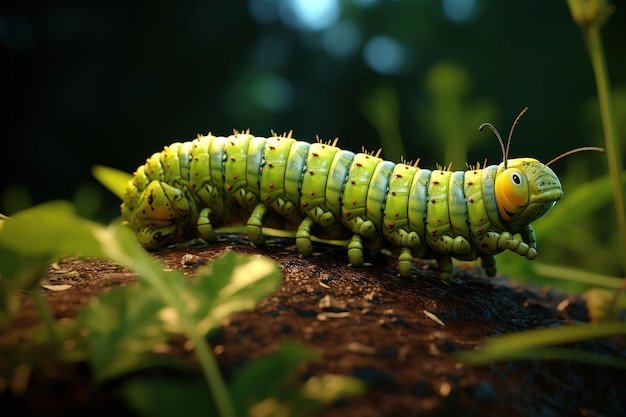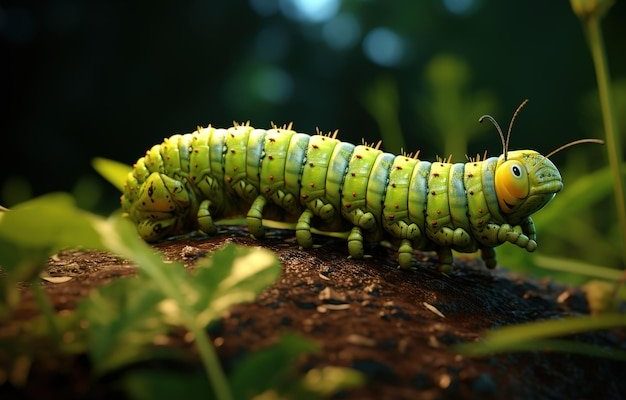
When you wander through a forest, you might not notice the tug-of-war happening right above you. Inchworms are known for their unique movement, mimicking twigs or leaves to avoid detection. But they’re not safe for long! Various birds, insects, and mammals have a keen eye for these sneaky little critters. As we dive deeper into the world of inchworm predators, you’ll see how each plays a vital role in maintaining healthy forest populations and biodiversity.
Birds: The Feathered Hunters
Birds are perhaps the most visible predators of inchworms. They’re like the watchful guardians of the trees, swooping in at the first hint of movement. Many birds, especially during the spring and summer, rely on inchworms as a significant part of their diet. Species such as **warblers, sparrows**, and **chickadees** are known to feast on these caterpillars.
Birds have excellent eyesight, allowing them to spot inchworms camouflaged among leaves. When inchworms are spotted, it’s a race. The birds swoop down, capturing their meal with swift beaks. This natural interaction helps control inchworm numbers, preventing potential outbreaks that can devastate trees. You might even notice a flock of birds darting between branches, chattering excitedly as they hunt. This is nature’s way of keeping balance.
Feeding and Nesting
Many birds choose to bring inchworms back to their nests to feed their young. This behavior not only provides vital nutrition for the chicks but also ensures that the next generation of birds will thrive. A mother bird that can find and catch enough inchworms will have healthier hatchlings, helping maintain the bird population in forest ecosystems.
So, the next time you hear the cheerful chirping of a bird, remember that it might just be looking for its next inchworm meal!
Insects: The Tiny Predators
In addition to birds, various insects are also on the hunt for inchworms. Think of them as the ninja warriors of the forest. Wasps, beetles, and even other caterpillars can be fierce inchworm predators. **Parasitic wasps**, for instance, lay their eggs inside inchworms, eventually leading to the inchworm’s demise. It’s a brutal yet fascinating part of nature’s cycle.
Ladybugs are another example. While they’re often associated with eating aphids, some species will consume small caterpillars as well, including those inchworms that might be lounging on a leaf. The variety of predators keeps the inchworm population in check, ensuring no single species can dominate the forest canopy.
Diversity in Action
The diverse array of insect predators shows just how interconnected forest life is. Each predator contributes to a larger web of life, where the absence of one can ripple through the ecosystem. For instance, if there’s a reduction in wasp populations, inchworm populations might surge, leading to potential plant damage. It’s a reminder that every creature, no matter how small, has a role to play.
Mammals: The Ground-Level Predators
While birds and insects often take the spotlight, let’s not forget about mammals. Small mammals like **mice**, **squirrels**, and even larger animals like **raccoons** will munch on inchworms when they can find them. These creatures often patrol the forest floor or climb trees, searching for an easy snack.
Mice are particularly adept at finding inchworms. They have an excellent sense of smell, which helps them locate these caterpillars hidden among the leaves. When inchworms fall to the ground or dangle from branches, they become targets for these ground-level hunters. This predation is crucial, as it helps prevent inchworm populations from exploding.
Seasonal Eating Habits
Interestingly, many mammals have seasonal diets that adjust according to food availability. During spring and summer, when inchworms are plentiful, you’ll find these small mammals actively hunting them. By autumn, as other food sources become available, inchworm predation may decrease. Yet, this seasonal ebb and flow of predator and prey is a natural rhythm that keeps the forest healthy.
Amphibians and Reptiles: The Stealthy Predators
In the damp underbrush of the forest, amphibians like **frogs** and **toads** also contribute to inchworm predation. They’re like the stealthy ninjas, waiting patiently for their next meal to wander by. With their quick tongues and keen senses, they can snatch up inchworms that venture too close to the ground.
Reptiles, such as **lizards**, play a similar role. They blend into their surroundings, camouflaging themselves against tree bark or leaves. When an inchworm is unsuspectingly close, the lizard will pounce, capturing its meal in a flash. This predator-prey relationship illustrates the intricate balance of forest ecosystems.
A Unique Hunting Technique
Many amphibians and reptiles employ unique hunting techniques. Frogs often sit still, waiting for the perfect moment to snap up an inchworm. Their patience pays off, as they can consume several inchworms in a single night. This practice not only keeps their energy up but also helps control inchworm populations.
Parasites: The Silent Killers
While we often think of animals eating inchworms, parasites take a different approach. These tiny organisms, such as nematodes and fungi, can infect inchworms, leading to their decline without ever being seen. It’s like a covert operation, quietly keeping inchworm numbers in check from the inside out.
The relationship between parasites and inchworms is a reminder of how complex nature can be. While it doesn’t seem fair that inchworms can fall victim to invisible attackers, this is a critical part of the cycle of life. Healthy ecosystems thrive on a mix of interactions, from visible predation to hidden parasitism.
The Role of Parasites in Ecosystem Health
Parasites can act as a natural form of pest control. When they target inchworms, they can prevent them from overpopulating and decimating vegetation. This type of regulation is essential for maintaining plant health and ensuring the entire ecosystem functions smoothly.
Natural predators of inchworms, from birds to mammals and even parasites, play a crucial role in forest ecosystems. They help maintain a balance, ensuring that no single species overwhelms the landscape. Without these predators, inchworm populations could explode, leading to severe consequences for the trees and plants they feed on.
So, the next time you stroll through a forest and spot an inchworm inching along, take a moment to appreciate the intricate web of life surrounding it. Each predator, whether feathered, furry, or hidden in the soil, contributes to a healthy, thriving ecosystem. Understanding these relationships helps us recognize the beauty and complexity of nature. After all, it’s all connected!

